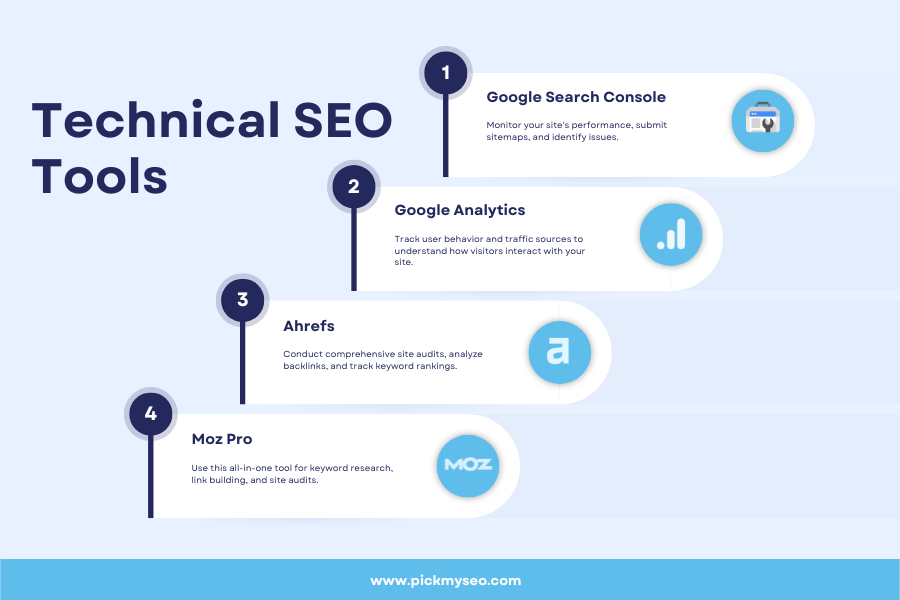What Is Technical SEO?
Technical SEO refers to the optimization of a website’s technical aspects to improve its search engine ranking. Unlike traditional SEO, which focuses on content and keywords, technical SEO deals with the backend elements of your site. This includes site speed, mobile-friendliness, indexing, security, and more. By addressing these technical factors, you can enhance your site’s performance, making it easier for search engines to crawl and index your pages.Why Is Technical SEO Important?
Technical SEO is crucial for several reasons:- Improved User Experience: A well-optimized site loads quickly, is mobile-friendly, and offers a seamless browsing experience, keeping users engaged.
- Better Search Engine Rankings: Search engines prioritize technically sound websites, improving your chances of ranking higher in search results.
- Increased Organic Traffic: Higher rankings lead to more visibility, driving organic traffic to your site.
- Enhanced Site Security: Implementing technical SEO practices like HTTPS and secure hosting protects your site and users from potential threats.
Technical SEO Checklist for 2024
To ensure your international website is optimized for technical SEO in 2024, follow this comprehensive checklist:1. Mobile-Friendliness
- Responsive Design: Your website design should look good and work well on different screen sizes and devices.
- Mobile Page Speed: Optimize images and reduce server response times to improve loading speed on mobile devices.
- Mobile-Friendly Test: Use tools like Google’s Mobile-Friendly Test to check your site’s mobile compatibility.
2. Site Speed
- Image Optimization: Compress images without compromising quality.
- Browser Caching: Implement caching to store frequently accessed files, reducing load times.
- Minify CSS and JavaScript: Remove unnecessary code to speed up your site.
3. Secure Sockets Layer (SSL)
- HTTPS: Ensure your site uses HTTPS to encrypt data and protect user information.
- SSL Certificate: Obtain and install an SSL certificate from a trusted provider.
4. XML Sitemap
- Comprehensive Sitemap: Create an XML sitemap that includes all important pages of your site.
- Submit your site map to search engines: Upload your site map to Google Search Console and Bing Webmaster Tools.
5. Robots.txt File
- Proper Configuration: Ensure your robots.txt file is correctly configured to guide search engine crawlers.
- Block Unimportant Pages: Prevent crawlers from indexing pages that don’t need to be in search results.
6. Structured Data Markup
- Schema Markup: Use schema.org to give search engines extra details about your content.
- Rich Snippets: Enhance search results with rich snippets, improving click-through rates.
7. Canonical Tags
- Avoid Duplicate Content: Use canonical tags to indicate the preferred version of a webpage, preventing duplicate content issues.
- Proper Implementation: Ensure canonical tags are correctly implemented on all relevant pages.
8. hreflang Tags
- Multilingual Sites: Use hreflang tags to specify the language and regional targeting of your content.
- Correct Syntax: Ensure hreflang tags are correctly formatted to avoid indexing errors.
9. Broken Links
- Regular Checks: Use tools to identify and fix broken links on your site.
- Redirects: Implement 301 redirects for permanently moved content to maintain link equity.
10. Site Architecture
- Clear Structure: Ensure your site has a logical and user-friendly structure.
- Breadcrumb Navigation: Implement breadcrumb navigation to improve user experience and internal linking.

Technical SEO Tools to Improve Your Site Performance
Leveraging the right tools can significantly enhance your technical SEO efforts. Here are some essential tools to consider:- Google Search Console: Monitor your site’s performance, submit sitemaps, and identify issues.
- Google Analytics: Track user behavior and traffic sources to understand how visitors interact with your site.
- Screaming Frog SEO Spider: Analyze your site’s structure, identify broken links, and audit your technical SEO.
- GTmetrix: Assess your site’s speed and get recommendations for improvements.
- Ahrefs: Conduct comprehensive site audits, analyze backlinks, and track keyword rankings.
- Yoast SEO: Optimize your WordPress site with this plugin, which offers technical SEO recommendations.
- Moz Pro: Use this all-in-one tool for keyword research, link building, and site audits.
Technical SEO Tips for International Websites
Optimizing an international website involves unique challenges. Here are specific technical SEO tips to help you succeed:1. Implement hreflang Tags
- Language and Region Targeting: Use hreflang tags to indicate the language and region of each page, helping search engines deliver the right content to the right audience.
- Avoid Duplicate Content: Proper hreflang implementation prevents duplicate content issues by clarifying content variations for different regions.
2. Use a Global CDN (Content Delivery Network)
- Faster Load Times: A CDN stores copies of your site on servers around the world, reducing load times for international users.
- Enhanced Security: CDNs offer protection against DDoS attacks and other security threats.
3. Optimize for Local Search Engines
- Regional Search Engines: Optimize your site for local search engines, such as Baidu in China or Yandex in Russia, to reach a wider audience.
- Local Keywords: Incorporate region-specific keywords to improve local search rankings.
4. Manage URL Structure
- Country Code Top-Level Domains (ccTLDs): Use ccTLDs (e.g., .uk, .de) for country-specific sites to signal to search engines the target country.
- Subdirectories or Subdomains: Consider using subdirectories (e.g., example.com/uk) or subdomains (e.g., uk.example.com) for different regions.
5. Localize Content
- Language and Culture: Translate and adapt your content to match the language and cultural nuances of each target region.
- Local Currency and Units: Display prices in local currency and use regional units of measurement.
6. Monitor International Performance
- Analytics Segmentation: Use tools like Google Analytics to segment traffic by country and language, gaining insights into regional performance.
- Search Console International Reports: Analyze international search performance with Google Search Console’s country and language reports.
7. Ensure Compliance with Local Regulations
- Data Protection Laws: Comply with regional data protection laws, such as GDPR in Europe or CCPA in California.
- Legal Requirements: Ensure your site adheres to local legal requirements, such as cookie consent and privacy policies.
Conclusion
Optimizing your website for international audiences requires a comprehensive approach to technical SEO. By following the tips and best practices outlined in this article, you can improve your site’s performance, enhance user experience, and boost your search engine rankings globally. Stay ahead in 2024 by prioritizing technical SEO and ensuring your website isFrequently Asked Questions
Hreflang tags indicate the language and regional targeting of a webpage, helping search engines deliver the right content to the right audience. This prevents duplicate content issues and improves search rankings for international sites.
Common technical SEO tools include Google Search Console, Google Analytics, Screaming Frog SEO Spider, GTmetrix, Ahrefs, Yoast SEO, and Moz Pro.
Using a global Content Delivery Network (CDN) can significantly improve load times for international users by storing copies of your site on servers around the world, reducing latency.
ccTLDs (e.g., .uk, .de) are country-specific domains, while subdirectories (e.g., example.com/uk) and subdomains (e.g., uk.example.com) are different methods of organizing content for different regions. Each has its advantages depending on your SEO strategy.
To ensure compliance with local regulations, stay informed about regional data protection laws (e.g., GDPR, CCPA) and implement necessary legal requirements like cookie consent and privacy policies.
Structured data markup, like schema.org, gives search engines more details about your content. This can enhance search results with rich snippets, improving click-through rates and visibility.
Site speed is crucial for SEO because faster-loading sites provide a better user experience, reduce bounce rates, and are favored by search engines, leading to higher rankings.
Use tools like Google Analytics and Google Search Console to monitor the performance of your international website. Segment traffic by country and language to gain insights into regional performance and make data-driven decisions.
By incorporating these technical SEO tips and tools, you can optimize your international website for better performance, user experience, and search engine rankings in 2024.







